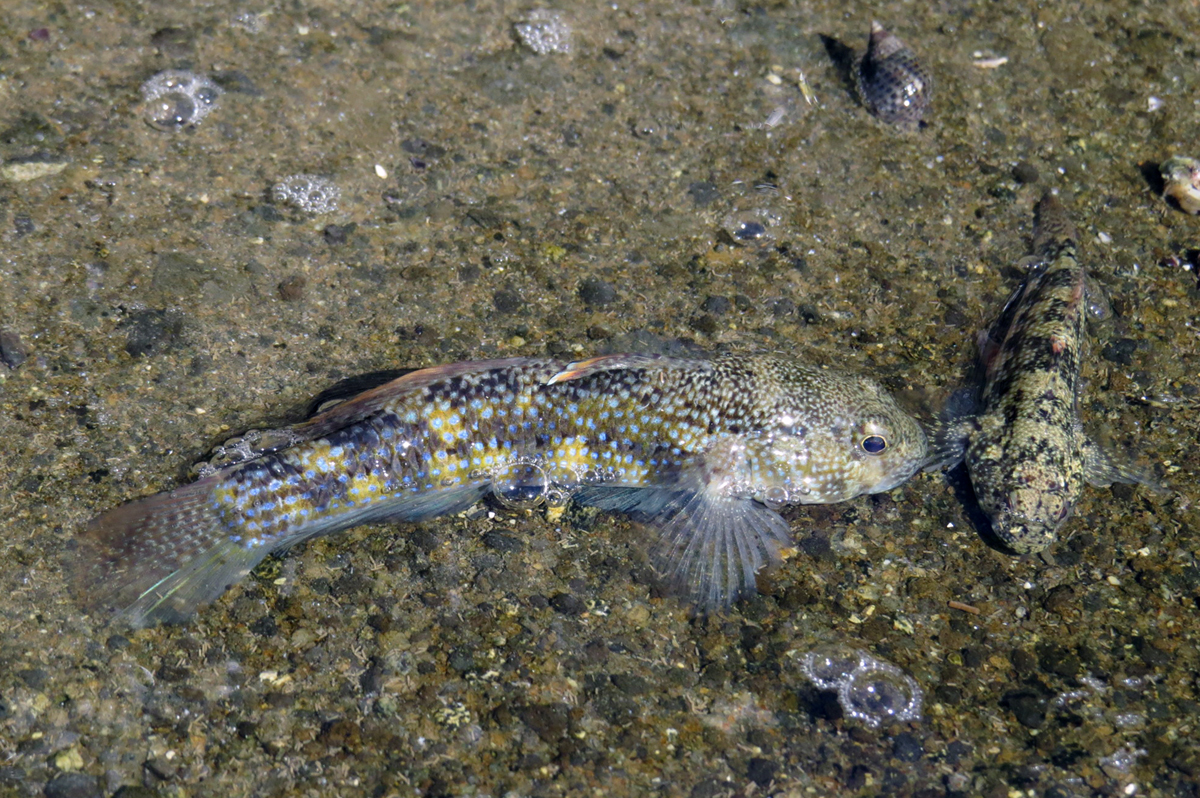Dusky Frillgoby, Bathygobius fuscus (Rüppell 1830)
Other Names: Dusky Frill-goby, Brown Frillfin, Brown Goby, Common Goby, Dusky Frillfin Goby, Frill Goby

Dusky Frillgobies, Bathygobius fuscus, at Kurrimine Beach, Queensland, December 2017. Source: coenobita / iNaturalist.org. License: CC by Attribution-NonCommercial
Summary:
A pale yellowish-brown goby with a large irregular brown markings on the body, small pale blue spots on each scale forming rows along the sides, small blue spots on dorsal and caudal fins, and a broad yellowish margin on the dorsal fins.
Cite this page as:
Bray, D.J. 2021, Bathygobius fuscus in Fishes of Australia, accessed 17 Apr 2024, https://fishesofaustralia.net.au/Home/species/2912
Dusky Frillgoby, Bathygobius fuscus (Rüppell 1830)
More Info
|
Distribution |
Seale Island, Western Australia, around the tropical north to Minnie Waters, New South Wales. Elsewhere, the species occurs in the tropical, Indo-west-central Pacific (east to Tonga, but absent from atolls of Pacific Plate). Inhabits sand and rubble, soft coral and open reef areas mostly in marine coastal waters. The Dusky Frillgoby also occurs estuaries and may enter the lower reaches of freshwater streams. |
|
Features |
Dorsal fin VI + I, 9; Anal fin I, 8; Pectoral fin 17-19, upper three rays partly free of membrane; Longitudinal scale series 29-36; Predorsal scales 10-19. Body depth 4.4-5.0 in SL, head depressed, width greater than depth; upper three pectoral rays partly free of membrane; caudal fin rounded; predorsal scales reaching from above middle of preopercle nearly to interorbital space; cheek and opercle without scales; body scales ctenoid, becoming cycloid on abdomen, breast and nape. |
|
Etymology |
The specific name is from the Latin fuscus (= dark, swarthy), in reference to the preserved colour of this species. |
|
Species Citation |
Gobius fuscus Rüppell 1830, Fische des Rothen Meeres. 3: 137. Type locality: Red Sea. |
|
Author |
Bray, D.J. 2021 |
|
Resources |
Dusky Frillgoby, Bathygobius fuscus (Rüppell 1830)
References
Akihito, P. & Meguro, K. 1980. On the six species of the genus Bathygobius found in Japan. Japanese Journal of Ichthyology 27(3): 215-236.
Allen, G.R. 1997. Marine Fishes of Tropical Australia and South-east Asia. Perth : Western Australian Museum 292 pp. 106 pls.
Allen, G.R. & Erdmann, M.V. 2012. Reef fishes of the East Indies. Perth : Tropical Reef Research 3 vols, 1260 pp.
Allen, G.R. & Swainston, R. 1988. The Marine Fishes of North-Western Australia. A field guide for anglers and divers. Perth, WA : Western Australian Museum vi 201 pp., 70 pls.
Alleyne, H.G. & Macleay, W.J. 1877. The ichthyology of the Chevert Expedition. Proceedings of the Linnean Society of New South Wales 1(3–4): 261-281, 321-359, pls 3-9, 10-17 (described from Darnley Island, Torres Strait as Gobius darnleyensis; described from Palm Island, Torres Strait as Gobius nigripinnis) See ref at BHL
Blaber, S.J.M., Young, J.W. & Dunning, M.C. 1985. Community structure and zoogeographic affinities of the coastal fishes of the Dampier region of north-western Australia. Australian Journal of Marine and Freshwater Research 36: 247-266.
Cole, K.S. 1990. Patterns of gonad structure in hermaphroditic gobies (Teleostei: Gobiidae). Environ. Biol. Fish. 28: 125-142.
Dahanukar, N., Allen, G., Williams, J.T., Burt, J. & Sparks, J.S. 2017. Bathygobius fuscus. The IUCN Red List of Threatened Species 2017: e.T172443A47917265. https://dx.doi.org/10.2305/IUCN.UK.2017-3.RLTS.T172443A47917265.en. Downloaded on 12 May 2020.
De Vis, C.W. 1884. New fishes in the Queensland Museum. No. 4. Proceedings of the Linnean Society of New South Wales 1 9(3): 685-698. (described from Cape York, Queensland as Gobius marginalis)
Depczynski, M. & Bellwood, D.R. 2003. The role of cryptobenthic reef fishes in coral reef trophodynamics. Marine Ecology Progress Series 256: 183-191.
Depczynski, M. & Bellwood, D.R. 2004. Microhabitat utilisation patterns in cryptobenthic coral reef fish communities. Marine Biology 145: 455-463.
Hutchins, B. 2004. Fishes of the Dampier Archipelago, Western Australia. Records of the Western Australian Museum, Supplement 66: 343–398.
Hutchins, J.B. 1994. A survey of the nearshore reef fish fauna of Western Australia's west and south coasts — The Leeuwin Province. Records of the Western Australian Museum, Supplement 46: 1-66 figs 1-6
Hutchins, J.B. 1997. Checklist of fishes of the Houtman Abrolhos Islands, Western Australia. pp. 239-253 in Wells, F. (ed.) The Marine Fauna and Flora of the Houtman Abrolhos Islands, Western Australia. Perth : Western Australian Museum.
Larson, H.K., Williams, R.S. & Hammer, M.P. 2013. An annotated checklist of the fishes of the Northern Territory, Australia. Zootaxa 3696(1): 1-293.
Larson, H.K. & Williams, R.S. 1997. Darwin Harbour fishes: a survey and annotated checklist. pp. 339-380 in Hanley, H.R., Caswell, G., Megirian, D. & Larson, H.K. (eds). The Marine Flora and Fauna of Darwin Harbour, Northern Territory, Australia. Proceedings of the Sixth International Marine Biology Workshop. Darwin : Museum and Art Gallery of the Northern Territory 466 pp.
Munro, I.S.R. 1967. The Fishes of New Guinea. Port Moresby : Dept. Agric. Stock Fish. 651 pp. 23 figs 84 pls.
Randall, J.E. 2005. Reef and shore fishes of the South Pacific. New Caledonia to Tahiti and the Pitcairn Islands. Honolulu : University of Hawaii Press 707 pp.
Randall, J.E., Allen, G.R. & Steene, R. 1990. Fishes of the Great Barrier Reef and Coral Sea. Bathurst : Crawford House Press 507 pp. figs.
Randall, J.E., Allen, G.R. & Steene, R. 1997. Fishes of the Great Barrier Reef and Coral Sea. Bathurst : Crawford House Press 557 pp. figs.
Rüppell, W.P.E. 1830. Atlas zu der Reise im nördlichen Afrika. Fische des Rothen Meeres. 3. Frankfurt : H.L. Brünner 95-141 pls 25-35 See ref at BHL
Whitley, G.P. 1955. Taxonomic notes on fishes. Proceedings of the Royal Zoological Society of New South Wales 1953–54: 44-57 figs 1-8 (described from Glastone, Queensland as Acentrogobius scrutarius) See ref at BHL






